Oculoauricular syndrome
| Oculoauricular syndrome | |
|---|---|
 | |
| Oculoauricular syndrome is inherited in an autosomal recessive manner. | |
| Specialty | Medical genetics |
Oculoauricular syndrome is a rare genetic condition affecting the eyes and ears. It is due to mutations in the H6 family homeobox 1 (HMX1) gene. It is also known as the Schorderet-Munier-Franceschetti syndrome.
Signs and symptoms
The clinical features of this condition are as follows:
Eyes
- microphthalmia
- coloboma
- nystagmus
- corneal sclerosis
- cataract
- glaucoma
- anterior synechiae
- posterior synechiae
- macular hypoplasia
- rod-cone dystrophy
- divergent strabismus
- posterior embryotoxon
Ears
- malformed pinnae
- low-set pinnae
- crumpled helix
- narrow external acoustic meatus
- coloboma of the lobules
Hearing is normal
Genetics
This condition is inherited in an autosomal recessive manner. The gene responsible is located on the short arm of chromosome 4 (4p16.1)[1]
Pathogensis
This is not presently understood.
Diagnosis
Differential diagnosis
This includes
- Morning glory syndrome
Epidemiology
This condition has only been described in three families to date (2017).
History
This condition was first described in 1945.[2] The gene responsible was identified in 2008.[1]
References
- 1 2 Schorderet, D.F.; Nichini, O.; Boisset, G.; Polok, B.; Tiab, L.; Mayeur, H.; Raji, B; de la Houssaye, G; Abitbol, M.M.; Munier, FL (2008). "Mutation in the human homeobox gene NKX5-3 causes an oculo-auricular syndrome". American Journal of Human Genetics. 82 (5): 1178–1184. doi:10.1016/j.ajhg.2008.03.007. PMC 2427260. PMID 18423520.
- ↑ Franceschetti, A/; Valerio, M. (1945). "Malformations associees des yeux et des oreilles". Confinia Neurologica. 6 (5): 255–257. doi:10.1159/000105978.
External links
This article is issued from Wmcloud. The text is licensed under Creative Commons - Attribution - Sharealike. Additional terms may apply for the media files.